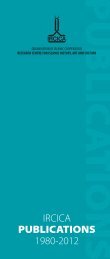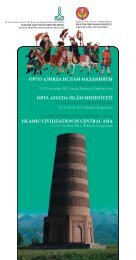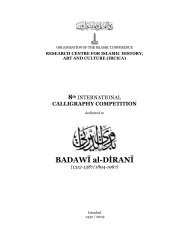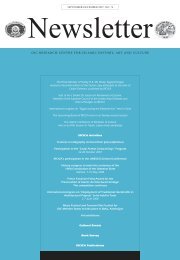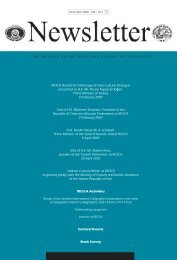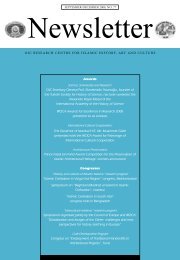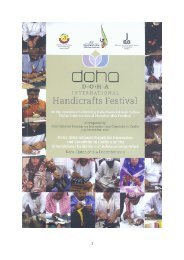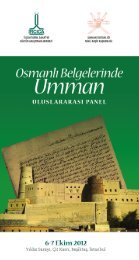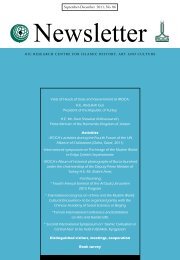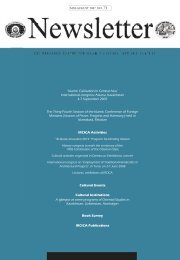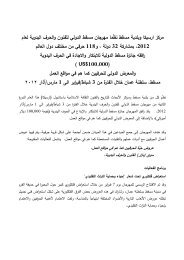Create successful ePaper yourself
Turn your PDF publications into a flip-book with our unique Google optimized e-Paper software.
IRCICA PUBLICATIONSAl-QudsJerusalem in historical photographsText: Kerim Balcı, Foreword: Ekmeleddin İhsanoğlu, Preface: Halit Eren, IRCICA,2009, xxxi, 435 pp. (in English, Arabic and Turkish editions)IRCICA PubilicationsThis publication resulted from a major project IRCICAdevoted to the preservation of the multiculturalarchitectural and urban heritage of Al-Quds/Jerusalem,“The” esteemed city of all the heavenly faith systems. TheCentre placed the book within the framework of the 40thanniversary commemoration of the Organisation of theIslamic Conference.Prof. Ekmeleddin İhsanoğlu, Secretary General of theOrganisation of the Islamic Conference, wrote the Forewordto the album. İhsanoğlu underlines the importance of Al-Quds/Jerusalem on universal scale, as a holy city for all threeheavenly religions. For Muslims, Al-Quds is the third holycity after Makkah and Madina. Masjid al-Aqsa (“The farthestmosque”) is Muslims’ first qibla – the direction faced whenpraying. Throughout its history of several millennias thecity has been the cradle of various faiths and cultures. It wasalways coveted by the main faith communities until moderntimes. The Secretary General then states that resolution ofthe conflict over Al-Quds and Palestine which is ongoingsince mid-20th century was the founding motive of theOIC in 1969 and remains its foremost cause today. The OICreiterated on all occasions its strong belief that the problemof Al-Quds is not just an Islamic issue but enjoys a widerreligious dimension. İhsanoğlu underlines in this regard thatpreservation of the multicultural character of the city withdue respect of the populations and the shrines of each faithis no doubt an indispensable part of any acceptable solutionof the problem.In the Preface, Dr. Halit Eren explains that in its capacityas the OIC’s research centre in charge of studies on history,culture and preservation of heritage, IRCICA carries outvarious activity programs relating to the urban, architecturaland socio-cultural heritage of Al-Quds and Palestine. Erenrefers to the history of Al-Quds/Jerusalem under the ruleof successive states and refers to the major restorationsconducted on Al-Quds monuments during Ottoman times;the city was almost renewed during the reign of Suleymanthe Magnificent with the restorations conducted at Qubbatas-Sakhra, the construction of walls, fountains, market placesand the repair of water canals. Due to its special importance,also, Al-Quds/Jerusalem was visited and described by manytravelers whose accounts provide information on variousaspects of the city. European travelers’ books sometimes alsocontain engravings. Then, the region became the first placeof interest of the pioneer photographers. The Ottoman Palacewas among the first in the world to acquire photographs ofthe region. Due to the special importance Sultan AbdülhamidII gave to Al-Quds, the Yıldız photograph collection whichwas formed during his reign contains a large number ofthem. The collection also contains prints taken by Ottomanphotographers.Mr. Kerim Balcı, political scientist, specialist of the historyof Al-Quds, reviews the developments in Jerusalemphotography in the Introduction of the book. The voluminouscollection of photographs contained in the book tells thehistory of the city during the last quarter of the 19th andthe first quarter of the 20th century through the lenses ofthe pioneer photographers who traveled to the Holy Landsshortly after the invention of photography techniques in thesecond half of the 19th century. Mr. Balcı gives instructiveinformation on the activities of the photographers. Theywere either religiously motivated – looking for evidencefrom early Christianity, amateur explorers of the East, orrich westerners investing in images of the East for a growingmarket demand. Due to the steady pace of development ofJerusalem photography from those early years onwards, theimages reproduced in the book reflect not only the city’sfeatures that changed or remained unchanged over time butalso the progress of techniques and artistic know-how duringthe decades that followed the invention.The album contains the reproductions of 470 photographsgathered from IRCICA’s archive comprising the YıldızPhotograph Albums and several other collections. Thesections are arranged under the following titles: PanoramicJerusalem, Al-Aqsa Mosque, The City and Its People, HolySites, Jerusalem’s History on Its Doors and in Its Streets,Jerusalem Streets, Professional Classes and Human Facesfrom Ottoman Jerusalem, Kaiser Wilhelm II visits Jerusalem,Ottoman Soldiers in Jerusalem and the Defense of the City. Thebook ends with special photographs on various themes andexisting hand-colored versions of some of the photographs.Researchers interested in various aspects of A-Quds, fromeconomic and social life to architecture, will benefit fromhaving this selected archival collection at hand’s reach.24 Newsletter September -December 2009, No: 80





